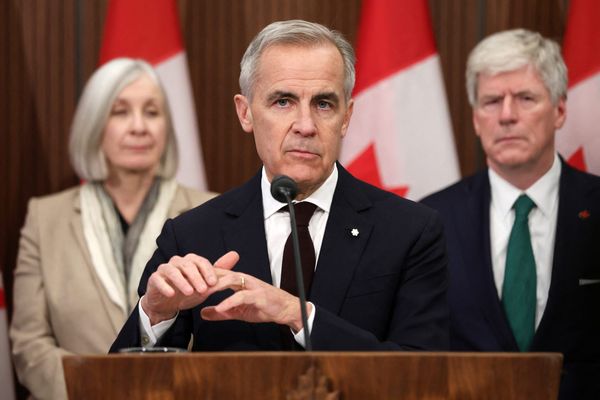
When a chunk of Victoria’s parliament fell on to an MP’s car, politicians finally decided something had to be done about the deteriorating state of the once-grand building.
Not much is known about the incident, and the premier at the time, Jeff Kennett, can’t recall it now, but according to a 1994 speech by the then Werribee MP, Ken Coghill, the building was quite literally crumbling apart.
“In particular its exterior is in a disgraceful condition,” Coghill said at the time.
“At the rear of the building, parts of the stonework are held together by wire netting to prevent them dropping on to the pavement below.”
Three decades since Coghill’s speech, Parliament House has returned to its former glory, with 16 years’ worth of stone restoration works coming to an end over the Christmas break.

Ari Indra, who has overseen the final few years of the works, says it was one of the largest heritage restoration projects in Australia’s history.
“There was literally no dull moment and no same day in parliament over the course of this project,” he tells Guardian Australia.
“There were school tours, protests, leadership spills, the pandemic – you name it – and all the while there were stonemasons diligently working away.”
A 78-metre high glass dome
Kennett was the first premier to seriously turn his mind to restoring parliament in the mid-1990s, setting up a building authority and allocating it $80m.
“I can’t remember the story about the car accident but it wasn’t my motivation,” he says.
Kennett says he wanted to complete the architect Peter Kerr’s original design for parliament, which includes a 78-metre high glass dome that was abandoned during the late 1880s economic depression.
“I sought support from the Labor party and the union movement that they would give me a guarantee that they weren’t going to strike or disrupt over this piece of public work. They refused to give me that,” he says.
Kennett refused to go ahead without bipartisan support.
“It would have been a wonderful attraction as you came up to see the Parliament House and the beautifully designed dome on the top of it. But it wasn’t to be,” he says.
Labor at the time, however, maintained they supported the project but opposed Kennett’s plan because it was would have allowed sandstone to be quarried from the protected Grampians national park to be used in the works.
At the 1999 election, Kennett floated the idea of relocating parliament to near Federation Square as a more cost-effective option than restoration. But instead, Labor’s Steve Bracks was elected, in a result that caught many political pundits by surprise.
Bracks went on to commit funding to fix parliament’s stonework in 2005.

Held together by coat hangers
According to Indra, the department of parliamentary services senior project manager, by this time, much of the stonework on Parliament House was either damaged or deteriorated.
“It was a bit of a mess,” he says.
Earlier attempts at restoration work had used different materials – sometimes even concrete – to patch up the stonework, which in part had been held together by wire, coat hangers and in one section a car aerial.
For about a year, architects and stonemasons worked together to catalogue every block and stone in the building to assess the damage.
At the same time, a search was undertaken to source stone as close to the original building, which the parliament’s library manager, Carolyn Macvean, says is actually several buildings interconnected.

“Parliament was built from the inside out – they built the chambers first in 1856, then the library, Queen’s Hall and then finally the sandstone facade,” she says.
“The original chambers were bluestone, which you can’t see from Spring Street but you can see when inside.”
The building is still technically unfinished, with a fireplace sitting in a rear facade – part of an expansion that never eventuated.

Bluestone quarried at Bramstone in Port Fairy, and sandstone from Gosford Quarries’ Piles Creek quarry in New South Wales were eventually selected, and transported to parliament in huge blocks.
Indra said a workshop was set up out the front of parliament where the stone was carved into shape – first by machines and then by hand by the 20-strong team of stonemasons. Each stone took up to three months to carve.
“It’s really a dying art,” he says of their work.
“We had six stonemasons that started off as apprentices and by the end of the project they were fully fledged artists.”

Columns and cornices were lovingly recreated, along with dozens of acorn motifs scattered through the building.
Macvean says as the oak tree can live for more than 1,000 years it symbolises strength, endurance, courage and prosperity. Acorns only appear on adult trees and are often a symbol of patience and the fruition of long, hard labour.
Intricacy and accuracy
In all, the work cost $88.9m, and was completed on 22 December 2023, when the scaffolding that has adorned the facade of parliament for more than a decade finally came down. The site handover was celebrated at an event with MPs, Indra’s project team and the workers.
Speaker Maree Edwards said she was one of many MPs who have only known parliament under scaffolding.
“Many Victorians won’t remember the building without some form of scaffolding, and some of the school visitor groups who attend the building won’t have been born when works began,” Edwards said.
“The front facade of Parliament House was completed 135 years ago in 1888, it’s a great credit to the skill of today’s stonemasons that they were able to repair the damaged stone to such an intricate and accurate level.”
Her counterpart in the upper house, Shaun Leane, encouraged Victorians to come and see the building for themselves.
“As temporary custodians of this important public building, I’m incredibly proud and grateful to see it so thoughtfully repaired and safeguarded for future generations,” he said.
“The level of local talent and skill employed in this project is clear to see in the completed work and I encourage all Victorians to come and witness it for themselves.”







